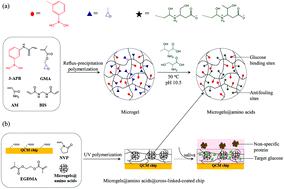Our official English website, www.x-mol.net, welcomes your
feedback! (Note: you will need to create a separate account there.)
A highly sensitive quartz crystal microbalance sensor modified with antifouling microgels for saliva glucose monitoring.
Nanoscale ( IF 5.8 ) Pub Date : 2020-08-22 , DOI: 10.1039/d0nr03193c Qian Dou 1 , Shiwen Wang , Zifeng Zhang , Yanxiang Wang , Zhipeng Zhao , Haijian Guo , Hongliang Liu , Qing Dai
Nanoscale ( IF 5.8 ) Pub Date : 2020-08-22 , DOI: 10.1039/d0nr03193c Qian Dou 1 , Shiwen Wang , Zifeng Zhang , Yanxiang Wang , Zhipeng Zhao , Haijian Guo , Hongliang Liu , Qing Dai
Affiliation

|
Saliva glucose detection based on quartz crystal microbalance (QCM) technology has become an important research direction of non-invasive blood glucose monitoring. However, the performance of this label-free glucose sensor is heavily deteriorated by the large amount of protein contaminants in saliva. Here, we successfully achieved the direct detection of saliva glucose by endowing the microgels on the QCM chip with superior protein-resistive and glucose-sensitive properties. Specifically, the microgel networks provide plenty of boric acid binding sites to amplify the signals of targeted glucose. The amino acid layer wrapped around the microgel and crosslinking layer can effectively eliminate the impact of non-specific proteins in saliva. The designed QCM sensor has a good linearity in the glucose concentration range of 0–40 mg L−1 in the pH range of 6.8–7.5, satisfying the physiological conditions of saliva glucose. Moreover, the sensor has excellent ability to tolerate proteins, enabling it to detect glucose in 50% human saliva. This result provides a new approach for non-invasive blood glucose monitoring based on QCM.
中文翻译:

高灵敏度的石英晶体微天平传感器,经防污微凝胶改性,可监测唾液葡萄糖。
基于石英晶体微天平(QCM)技术的唾液葡萄糖检测已成为无创血糖监测的重要研究方向。但是,这种无标签的葡萄糖传感器的性能因唾液中的大量蛋白质污染物而严重恶化。在这里,我们通过将Qgel芯片上的微凝胶赋予蛋白抗性和葡萄糖敏感特性,成功实现了唾液葡萄糖的直接检测。具体而言,微凝胶网络提供了大量的硼酸结合位点,以放大目标葡萄糖的信号。包裹在微凝胶和交联层周围的氨基酸层可以有效消除唾液中非特异性蛋白质的影响。设计的QCM传感器在0-40 mg L的葡萄糖浓度范围内具有良好的线性在6.8-7.5的pH范围内为-1,满足唾液葡萄糖的生理条件。此外,该传感器具有出色的蛋白质耐受能力,使其能够检测50%的人类唾液中的葡萄糖。该结果为基于QCM的无创血糖监测提供了一种新方法。
更新日期:2020-10-02
中文翻译:

高灵敏度的石英晶体微天平传感器,经防污微凝胶改性,可监测唾液葡萄糖。
基于石英晶体微天平(QCM)技术的唾液葡萄糖检测已成为无创血糖监测的重要研究方向。但是,这种无标签的葡萄糖传感器的性能因唾液中的大量蛋白质污染物而严重恶化。在这里,我们通过将Qgel芯片上的微凝胶赋予蛋白抗性和葡萄糖敏感特性,成功实现了唾液葡萄糖的直接检测。具体而言,微凝胶网络提供了大量的硼酸结合位点,以放大目标葡萄糖的信号。包裹在微凝胶和交联层周围的氨基酸层可以有效消除唾液中非特异性蛋白质的影响。设计的QCM传感器在0-40 mg L的葡萄糖浓度范围内具有良好的线性在6.8-7.5的pH范围内为-1,满足唾液葡萄糖的生理条件。此外,该传感器具有出色的蛋白质耐受能力,使其能够检测50%的人类唾液中的葡萄糖。该结果为基于QCM的无创血糖监测提供了一种新方法。











































 京公网安备 11010802027423号
京公网安备 11010802027423号